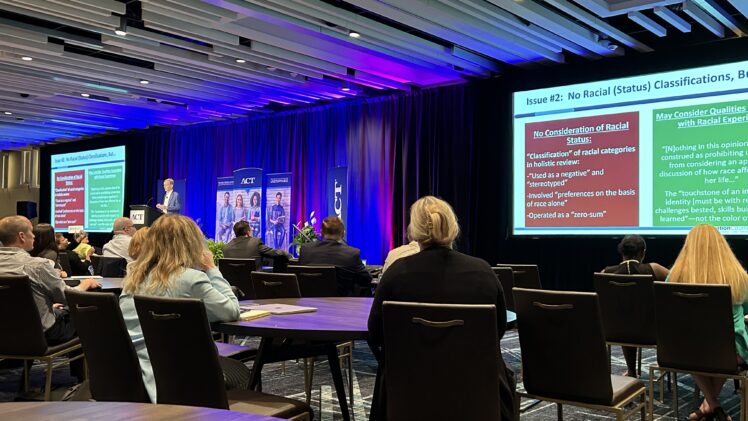Kicking off the 36th ACT Enrollment Planners Summit in Nashville, Tennessee, this week was Art Coleman, Managing Partner and Co-Founder of Education Counsel, LLC, leading the opening keynote on Race in Admissions: Analysis of the Supreme Court Ruling and Implications for Enrollment Managers.
The topic was timely, of course, in the aftermath of the Supreme Court rulings that race-based admissions practices at Harvard and the University of North Carolina were unconstitutional.
Below is a summary of his session offering guidance to college and university enrollment leaders as they work to understand what these decisions mean for admissions.
Your goals are your goals, and nothing will stand in the way of that.
Many schools are highly mission-oriented, with deep commitments to diversity and access. They believe in the importance of ensuring that all members of the community—regardless of race, ethnicity, socioeconomic status, or any other potential barrier, have equitable access to higher education.
Coleman reminded attendees that the Supreme Court’s ruling cannot alter a school’s goals and advised enrollment leaders to reaffirm their commitment to their goals and focus on what they can do to achieve them.
The Court’s majority opinion asserted, “Universities may define their missions as they see fit.”
You cannot consider race alone, but you can embrace qualities associated with racial experience.
Coleman pointed out the Court’s distinction between evaluating a student based on their race alone versus considering qualities associated with racial experience. Each student must be evaluated on a variety of criteria and cannot be admitted based on a “check the box” status determination.
However, schools may have an essay or interview question to understand how a student has handled racial adversity or how the subject of race has shaped their life experience. Schools do not have to be race-blind in their reading.
The Court did not expressly address anything beyond admissions decisions.
Not included in the Court’s opinion was guidance on scholarships and financial aid, outreach and recruitment, pipeline and pathways programs, data collection, employment, or other race-neutral strategies.
Coleman touched on each, offering his own legal perspective for education leaders, though explicitly stated each institution should engage its own legal counsel on these matters before taking any action:
Financial Aid and Scholarships
The Court’s opinion will shape financial aid and scholarship decisions. If schools have race-based awards, they should engage with their legal counsel to determine if there is a compelling interest. Coleman’s advice was to leverage what the Court said you can do.
Outreach and Recruitment
Nothing in the Court’s decision indicates schools should change their recruitment practices, even when race is a driving force.
“Inclusive programs should remain a key focus’
-Art Coleman
Other Race-Neutral Strategies
This decision will undoubtedly lead to new strategies and/or differently framed interests to support diversity goals. This is an opportunity for enrollment teams to get creative, provided they have consulted with legal counsel and are operating within broad legal parameters.
Conduct a comprehensive enrollment policy evaluation.
Colman advised each campus to conduct a comprehensive evaluation to ensure its policies and plans are mission-focused, aligned, and integrated.
This evaluation should focus on four key areas:
Pathways
With your DEI goals front and center, consider where and how to target the right students to grow your pipeline and increase pathways for students.
Barriers
Are barriers evident in any of your current practices that may merit reconsideration? For example, legacy programs, Early Decision/Early Action, test optional applications, and transfer policies.
Use this question as a guide: “Can we engage publicly to defend these practices?”
Admission
Ensure you have a holistic review process and clear articulation of desired qualities. Remember you are able to consider legally neutral, DEI-focused qualities.
Race-Neutral Strategies
These [sometimes] new strategies should be authentic to your campus and your goals and they should span the breadth of your enrollment policy.
In the October 2022 oral arguments, Chief Justice Roberts said, “[If the practice of checking the box is taken away], maybe there will be an incentive for the university to, in fact, truly pursue race-neutral alternatives, such as, you know, allowing… applicants to indicate experiences they have had because of race.”
Move forward with bold innovation and transparency.
Coleman believes we’re now in an era that will demand transparency and documentation.
His final pieces of advice?
- Engage with stakeholders on directional shifts and potential impacts now
- Use data and research to ground your decisions
- Evaluate and make policy changes if you find you are not compliant and/or are at legal risk
- Develop training materials that align with policy articulation
- Ensure all stakeholders are aware of any changes to policy and that all messaging is aligned
Coleman believes this is the time to be bold. Higher education is resilient and will find new ways to achieve its goals.
A big thanks to ACT for hosting an inspiring conference and to Art Coleman for sharing his wisdom on this important topic.
